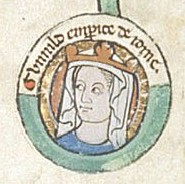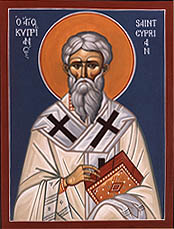|
Nortpert
Nortpert (died after 1076) was abbot of the Abbey of Saint Gall from 1034 to 1072. Works Nortpert was called to Saint Gall from the reform monastery Stavelot in order to reintroduce a strict monastic way of life. Despite resistance on the part of the monks of Saint Gall, he was able to successfully assert a reform programme. In 1040, he welcomed King Henry III whom he accompanied on his campaign in Italy in 1046. In Rome in 1047, he obtained the canonisation of Saint Gall's local saint Wiborada who died as a martyr in the course of the Hungarian invasions The Hungarian invasions of Europe ( hu, kalandozások, german: Ungarneinfälle) took place in the 9th and 10th centuries, the period of transition in the history of Europe in the Early Middle Ages, when the territory of the former Carolingian Em .... As an abbot who tried to preserve the property rights of his monastery, he came into a bloody conflict with Bishop Rumold von Konstanz. After 38 years in office, he abdicated in ... [...More Info...] [...Related Items...] OR: [Wikipedia] [Google] [Baidu] |
Abbey Of Saint Gall
The Abbey of Saint Gall (german: Abtei St. Gallen) is a dissolved abbey (747–1805) in a Catholic religious complex in the city of St. Gallen in Switzerland. The Carolingian-era monastery existed from 719, founded by Saint Othmar on the spot where Gallus had erected his hermitage. It became an independent principality between 9th and 13th centuries, and was for many centuries one of the chief Benedictine abbeys in Europe. The library of the Abbey is one of the oldest monastic libraries in the world. The city of St. Gallen originated as an adjoining settlement of the abbey. The abbey was secularized around 1800, and in 1848 its former church became a Cathedral. Since 1983 the abbey precinct has been a UNESCO World Heritage Site. History Foundation Around 612 Gallus, according to tradition an Irish monk and disciple and companion of Saint Columbanus, established a hermitage on the site that would become the monastery. He lived in his cell until his death in 646, a ... [...More Info...] [...Related Items...] OR: [Wikipedia] [Google] [Baidu] |
Abbot
Abbot is an ecclesiastical title given to the male head of a monastery in various Western religious traditions, including Christianity. The office may also be given as an honorary title to a clergyman who is not the head of a monastery. The female equivalent is abbess. Origins The title had its origin in the monasteries of Egypt and Syria, spread through the eastern Mediterranean, and soon became accepted generally in all languages as the designation of the head of a monastery. The word is derived from the Aramaic ' meaning "father" or ', meaning "my father" (it still has this meaning in contemporary Hebrew: אבא and Aramaic: ܐܒܐ) In the Septuagint, it was written as "abbas". At first it was employed as a respectful title for any monk, but it was soon restricted by canon law to certain priestly superiors. At times it was applied to various priests, e.g. at the court of the Frankish monarchy the ' ("of the palace"') and ' ("of the camp") were chaplains to the Merov ... [...More Info...] [...Related Items...] OR: [Wikipedia] [Google] [Baidu] |
1034
Year 1034 ( MXXXIV) was a common year starting on Tuesday (link will display the full calendar) of the Julian calendar. Events By place Byzantine Empire * April 11 – Emperor Romanos III (Argyros) is drowned in his bath, at the urging of his wife Zoë, who marries her chamberlain, and elevates him to the throne of the Byzantine Empire, as Michael IV. Romanos is buried in the Church of St. Mary Peribleptos in Constantinople. Europe * Spring – Emperor Conrad II (the Elder) leads a German military expedition via the Rhone River into Burgundy, while two Italian armies led by Archbishop Aribert and Boniface III (margrave of Tuscany) head over the Alps and join with Count Humbert I at Great St. Bernard Pass. * March – Conrad II converges his armies on Lake Lemano and defeats Count Odo II in battle at Geneva (modern Switzerland). For his assistance, Conrad grants Humbert I with the Burgundian county of Maurienne. * May – King Mieszko II die ... [...More Info...] [...Related Items...] OR: [Wikipedia] [Google] [Baidu] |
1072
Year 1072 ( MLXXII) was a leap year starting on Sunday (link will display the full calendar) of the Julian calendar. Events By place Byzantine Empire * June 29 – Romanos IV (Diogenes), deposed emperor of the Byzantine Empire, is blinded and sent into exile to the island of Proti (in the Sea of Marmara) at the Monastery of Transfiguration. A few days before his death, he receives a letter from Michael Psellos (his political advisor), congratulating him on the loss of his eyes.John Julius Norwich (1991). ''Byzantium: The Apogee – The Disaster'', p. 357. . Europe * January 10 – The Normans under Robert Guiscard and his brother Roger I (Boso) conquer Palermo (after a one year siege). Roger receives the keys of the city, and Robert invests him with the title of Count of Sicily. The Emirate of Sicily rules only the southern part of the island, with Syracuse as the capital (until 1091). * January – Battle of Golpejera: King Sancho II (the Stro ... [...More Info...] [...Related Items...] OR: [Wikipedia] [Google] [Baidu] |
Henry III, Holy Roman Emperor
Henry III (28 October 1016 – 5 October 1056), called the Black or the Pious, was Holy Roman Emperor from 1046 until his death in 1056. A member of the Salian dynasty, he was the eldest son of Conrad II and Gisela of Swabia. Henry was raised by his father, who made him Duke of Bavaria in 1026, appointed him co-ruler in 1028 and bestowed him with the duchy of Swabia and the Kingdom of Burgundy ten years later in 1038. The emperor's death the following year ended a remarkably smooth and harmonious transition process towards Henry's sovereign rule, that was rather uncharacteristic for the Ottonian and Salian monarchs. Henry succeeded Conrad II as Duke of Carinthia and King of Italy and continued to pursue his father's political course on the basis of ''virtus et probitas'' (courage and honesty), which led to an unprecedented sacral exaltation of the kingship. In 1046 Henry ended the papal schism, was crowned Emperor by Pope Clement II, freed the Vatican from dependence on t ... [...More Info...] [...Related Items...] OR: [Wikipedia] [Google] [Baidu] |
Canonization
Canonization is the declaration of a deceased person as an officially recognized saint, specifically, the official act of a Christian communion declaring a person worthy of public veneration and entering their name in the canon catalogue of saints, or authorized list of that communion's recognized saints. Catholic Church Canonization is a papal declaration that the Catholic faithful may venerate a particular deceased member of the church. Popes began making such decrees in the tenth century. Up to that point, the local bishops governed the veneration of holy men and women within their own dioceses; and there may have been, for any particular saint, no formal decree at all. In subsequent centuries, the procedures became increasingly regularized and the Popes began restricting to themselves the right to declare someone a Catholic saint. In contemporary usage, the term is understood to refer to the act by which any Christian church declares that a person who has died is a sain ... [...More Info...] [...Related Items...] OR: [Wikipedia] [Google] [Baidu] |
Wiborada
Wiborada of St. Gall (also Guiborat, Weibrath or Viborata; Alemannic: ''Wiberat'') (died 926) was a member of the Swabian nobility in what is present-day Switzerland. She was an anchoress, Benedictine nun, and martyr. Biography There are two biographies of Wiborada: one by Hartmann, a monk of St. Gall, written between 993 and 1047 ( BHL 8866); and another written between 1072 and 1076 by the monk Herimannus ( BHL 8867). Wiborada was born to a wealthy noble family in Swabia. When they invited the sick and poor into their home, Wiborada proved a capable nurse. Her brother Hatto became a priest. A pilgrimage to Rome influenced Hatto to decide to become a monk at the Abbey of Saint Gall, a decision which Wiborada supported. After the death of their parents, Wiborada joined Hatto and became a Benedictine at the Abbey of Saint Gall. Wiborada became settled at the monastery and Hatto taught her Latin so that she could chant the Liturgy of the Hours. There, she occupied herself by ma ... [...More Info...] [...Related Items...] OR: [Wikipedia] [Google] [Baidu] |
Martyr
A martyr (, ''mártys'', "witness", or , ''marturia'', stem , ''martyr-'') is someone who suffers persecution and death for advocating, renouncing, or refusing to renounce or advocate, a religious belief or other cause as demanded by an external party. In the martyrdom narrative of the remembering community, this refusal to comply with the presented demands results in the punishment or execution of an actor by an alleged oppressor. Accordingly, the status of the 'martyr' can be considered a posthumous title as a reward for those who are considered worthy of the concept of martyrdom by the living, regardless of any attempts by the deceased to control how they will be remembered in advance. Insofar, the martyr is a relational figure of a society's boundary work that is produced by collective memory. Originally applied only to those who suffered for their religious beliefs, the term has come to be used in connection with people killed for a political cause. Most martyrs are conside ... [...More Info...] [...Related Items...] OR: [Wikipedia] [Google] [Baidu] |
Hungarian Invasions Of Europe
The Hungarian invasions of Europe ( hu, kalandozások, german: Ungarneinfälle) took place in the 9th and 10th centuries, the period of transition in the history of Europe in the Early Middle Ages, when the territory of the former Carolingian Empire was threatened by invasion from multiple hostile forces, the Magyars (Hungarians) from the east, the Viking expansion from the north and the Arabs from the south.Barbara H. Rosenwein, A short history of the Middle Ages, University of Toronto Press, 2009, p. 15/ref> The Magyars successfully Hungarian conquest of the Carpathian Basin, conquered the Carpathian Basin (corresponding to the later Kingdom of Hungary) by the end of the ninth century, and launched a number of plundering raids both westward into former Francia and southward into the Byzantine Empire. The westward raids were stopped only with the Magyar defeat of the Battle of Lechfeld of 955, which led to a new political order in Western Europe centered on the Holy Roman Em ... [...More Info...] [...Related Items...] OR: [Wikipedia] [Google] [Baidu] |
Rumold Von Konstanz
{{given name ...
Rumwold (sometimes Rumbold) is an Old English name used to refer to: *Rumwold of Buckingham, infant saint commemorated at Buckingham * Rumbold of Mechelen, saint commemorated at Mechelen See also *Rumbold (other) Rumbold (sometimes Rumwold) is an Old English name that may refer to: People * St. Rumbold of Buckingham (662), English infant saint *Saint Rumbold of Mechelen (6th/7th/8th century?), Irish or Scottish Christian missionary * Rumbold baronets includ ... [...More Info...] [...Related Items...] OR: [Wikipedia] [Google] [Baidu] |
Abbots Of Saint Gall
Abbot is an ecclesiastical title given to the male head of a monastery in various Western religious traditions, including Christianity. The office may also be given as an honorary title to a clergyman who is not the head of a monastery. The female equivalent is abbess. Origins The title had its origin in the monasteries of Egypt and Syria, spread through the eastern Mediterranean, and soon became accepted generally in all languages as the designation of the head of a monastery. The word is derived from the Aramaic ' meaning "father" or ', meaning "my father" (it still has this meaning in contemporary Hebrew: אבא and Aramaic: ܐܒܐ) In the Septuagint, it was written as "abbas". At first it was employed as a respectful title for any monk, but it was soon restricted by canon law to certain priestly superiors. At times it was applied to various priests, e.g. at the court of the Frankish monarchy the ' ("of the palace"') and ' ("of the camp") were chaplains to the Merovingian an ... [...More Info...] [...Related Items...] OR: [Wikipedia] [Google] [Baidu] |
11th-century Deaths
The 11th century is the period from 1001 ( MI) through 1100 ( MC) in accordance with the Julian calendar, and the 1st century of the 2nd millennium. In the history of Europe, this period is considered the early part of the High Middle Ages. There was, after a brief ascendancy, a sudden decline of Byzantine power and a rise of Norman domination over much of Europe, along with the prominent role in Europe of notably influential popes. Christendom experienced a formal schism in this century which had been developing over previous centuries between the Latin West and Byzantine East, causing a split in its two largest denominations to this day: Roman Catholicism and Eastern Orthodoxy. In Song dynasty China and the classical Islamic world, this century marked the high point for both classical Chinese civilization, science and technology, and classical Islamic science, philosophy, technology and literature. Rival political factions at the Song dynasty court created strife among ... [...More Info...] [...Related Items...] OR: [Wikipedia] [Google] [Baidu] |







